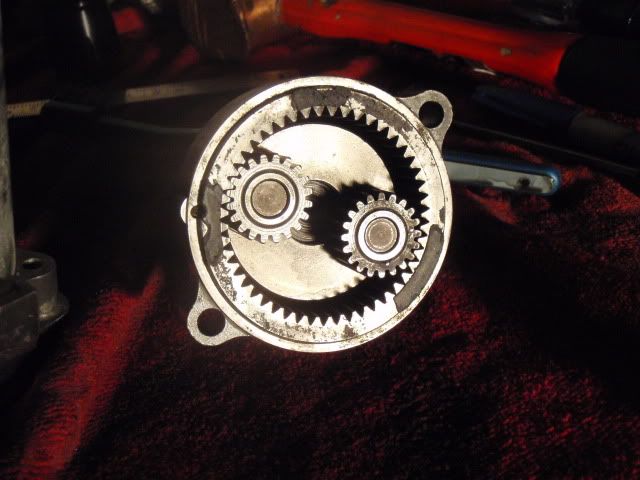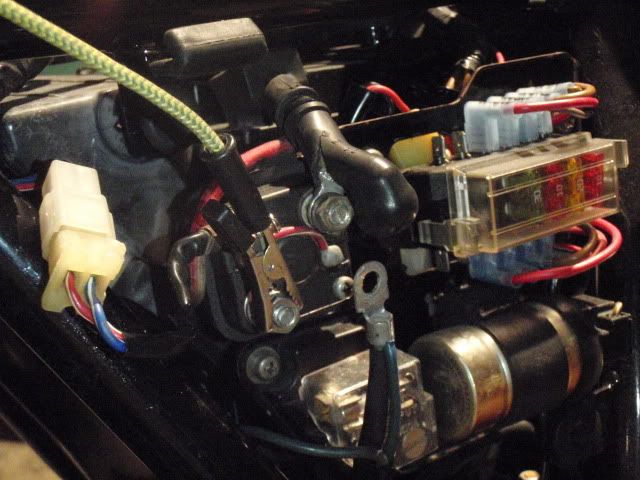While I've been out in the Man Cave I see that you guys have been busy doing some analysis...excellent 
Here is what I have to report.
I started taking some voltage readings per Larry's post and I got some wacked out results I placed the meter across the battery terminals and cranked it over. Without the spark plugs in I started with 13.4v and that dropped to 11.9v. I installed the spark plugs and noted that I had 13.9v with the key off. Turning the key on dropped it to 13.5v and cranking the engine dropped it to 8v and continued to drop
I placed the meter across the battery terminals and cranked it over. Without the spark plugs in I started with 13.4v and that dropped to 11.9v. I installed the spark plugs and noted that I had 13.9v with the key off. Turning the key on dropped it to 13.5v and cranking the engine dropped it to 8v and continued to drop  I've noticed I get a steady voltage drop as soon as I turn the key on. Plugs in or out doesn't matter...I just didn't notice it until after the plugs were installed.
I've noticed I get a steady voltage drop as soon as I turn the key on. Plugs in or out doesn't matter...I just didn't notice it until after the plugs were installed.
Next I placed the meter across the positive battery terminal and starter cable lug. I got a total voltage loss...it went down to zero
Next I placed the meter across the positive battery terminal and the starter side of the starter solenoid. Again total voltage loss
So, I tried to open up the solenoid but couldn't get it to come apart. I got to seperate just enough to see a little inside, but it felt like it wasn't meant to look inside any farther. So I bolted it back up, installed it, and it still worked.
So next I removed the starter.

I cleaned it up and checked the brushes. They look fine and have plenty of life left.

Everything fit back OK. I also checked each winding for shorts and didn't find any. No problem with the starter lug insulation and case.

I cleaned up the mechanical end and bolted it all back, but didn't perform any better than before

I tried a different test on the solenoid. I removed the starter cable and placed the meter across the solenoid starter side lug and negative cable. I hit the starter button and recorded a 3.5 volt drop However after a couple of time of doing that the solenoid stuck in the off position.
However after a couple of time of doing that the solenoid stuck in the off position.
So we will find out if the solenoid was a problem when a new one arrives
I looked up my receipts and see that I bought the battery in March 2009...so it is about 11 months old and set unused untill now. And we had two bitter freezing storms that lasted for several weeks this winter...no doubt an effect of global warming So I can't eliminate that the issue is a good battery gone bad
So I can't eliminate that the issue is a good battery gone bad 
I still have to check out the ground connections, and once I get a replacement solenoid I can try that suggestion to disconnect the negative cable and jump it from the truck battery.
BTW, I don't think the engine is so tight that it is preventing it from turning over. It turns over fairly normal with the spark plugs out, but slows down to about one cylinder per second with the spark plugs in
So maybe it's a bad solenoid and bad battery. I guess I could see if one of the auto parts stores can do a stress test on a battery that small
Does this open up any new ideas

Here is what I have to report.
I started taking some voltage readings per Larry's post and I got some wacked out results
 I placed the meter across the battery terminals and cranked it over. Without the spark plugs in I started with 13.4v and that dropped to 11.9v. I installed the spark plugs and noted that I had 13.9v with the key off. Turning the key on dropped it to 13.5v and cranking the engine dropped it to 8v and continued to drop
I placed the meter across the battery terminals and cranked it over. Without the spark plugs in I started with 13.4v and that dropped to 11.9v. I installed the spark plugs and noted that I had 13.9v with the key off. Turning the key on dropped it to 13.5v and cranking the engine dropped it to 8v and continued to drop  I've noticed I get a steady voltage drop as soon as I turn the key on. Plugs in or out doesn't matter...I just didn't notice it until after the plugs were installed.
I've noticed I get a steady voltage drop as soon as I turn the key on. Plugs in or out doesn't matter...I just didn't notice it until after the plugs were installed.Next I placed the meter across the positive battery terminal and starter cable lug. I got a total voltage loss...it went down to zero

Next I placed the meter across the positive battery terminal and the starter side of the starter solenoid. Again total voltage loss

So, I tried to open up the solenoid but couldn't get it to come apart. I got to seperate just enough to see a little inside, but it felt like it wasn't meant to look inside any farther. So I bolted it back up, installed it, and it still worked.
So next I removed the starter.

I cleaned it up and checked the brushes. They look fine and have plenty of life left.

Everything fit back OK. I also checked each winding for shorts and didn't find any. No problem with the starter lug insulation and case.

I cleaned up the mechanical end and bolted it all back, but didn't perform any better than before


I tried a different test on the solenoid. I removed the starter cable and placed the meter across the solenoid starter side lug and negative cable. I hit the starter button and recorded a 3.5 volt drop
 However after a couple of time of doing that the solenoid stuck in the off position.
However after a couple of time of doing that the solenoid stuck in the off position.So we will find out if the solenoid was a problem when a new one arrives

I looked up my receipts and see that I bought the battery in March 2009...so it is about 11 months old and set unused untill now. And we had two bitter freezing storms that lasted for several weeks this winter...no doubt an effect of global warming
 So I can't eliminate that the issue is a good battery gone bad
So I can't eliminate that the issue is a good battery gone bad 
I still have to check out the ground connections, and once I get a replacement solenoid I can try that suggestion to disconnect the negative cable and jump it from the truck battery.
BTW, I don't think the engine is so tight that it is preventing it from turning over. It turns over fairly normal with the spark plugs out, but slows down to about one cylinder per second with the spark plugs in

So maybe it's a bad solenoid and bad battery. I guess I could see if one of the auto parts stores can do a stress test on a battery that small

Does this open up any new ideas


 )
) 
 (Sold back to Maximan)
(Sold back to Maximan)
Comment